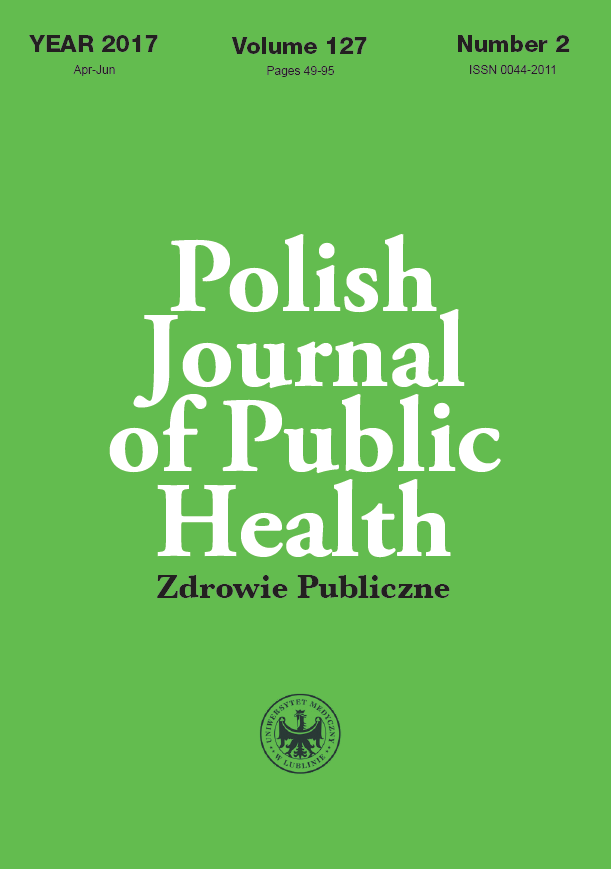Women’s knowledge on activities associated with maternal hyperthermia during pregnancy. A cross-sectional study of the sample of Polish women
DOI:
https://doi.org/10.1515/pjph-2017-0013Keywords:
congenital abnormalities, heat, high temperature, induced hyperthermia, pregnancyAbstract
Introduction. Hyperthermia during the first trimester increases the risk of miscarriage and birth defects. A variety of activities predisposing to hyperthermia during pregnancy such as attending sauna, hot tubs or solarium may lead to irreversible abnormalities of the developing fetus.
Aim. The aim of the study was to assess women‘s knowledge on the risks of maternal hyperthermia during each trimester of pregnancy.
Material and methods. It was a cross-sectional study conducted by means of an anonymous questionnaire. The study group included 302 women aged 17-65 who were admitted to a tertiary referral hospital. The questionnaire was designed on the basis of the Committee Opinion formulated by the American College of Obstetricians and Gynecologists and was consisted of two sections: demographic data and respondents‘ opinions on activities associated with hyperthermia in pregnancy. Statistical analysis was conducted to estimate the association of age, level of education and obstetrical status.
Results. The lowest percentage of given proper answers was observed in case of questions about early pregnancy. There was no association between respondents‘ level of education and choice of correct answers. Current pregnancy was associated with higher awareness of contraindicated using of hot tubs and steam rooms.
Conclusions. Patients‘ education concerning hyperthermia in pregnancy should focus on information about high risk of birth defects caused by overheating in the early pregnancy and a variety of activities linked with temperature elevation.
References
1. Edwards MJ, Shiota K, Smith MSR, Walsh DA. Hyperthermia and birth defects. Reprod Toxicol. 1995;9:411-25.
2. Chambers CD. Risks of hyperthermia associated with hot tub or spa use by pregnant women. Birth Defects Res A Clin Mol Teratol. 2006;76:569-73.
3. Milunsky A, Ulcickas M, Rothman KJ, et al. Maternal heat exposure and neural tube defects. JAMA.1992;268:882-5.
4. Li DK, Janevic T, Odouli R, Liu L. Hot tub use during pregnancy and the risk of miscarriage. Am J Epidemiol. 2003;158(10):931-7.
5. Duong HT, Shahrukh Hashmi S, Ramadhani T, et al. National Birth Defects Prevention Study. Maternal use of hot tub and major structural birth defects. Birth Defects Res A Clin Mol Teratol. 2001;91:836-41.
6. The American College of Obstetricians and Gynecologists, Committee opinion, Committee on Obstetric Practice, n 650, December 2015.
7. Edwards MJ. Apoptosis, the heat shock response, hyperthermia, birth defects, disease and cancer. Where are the common links? Cell Stress Chaperones. 1998;3(4):213-20.
8. Germain MA, Webster WS, Edwards MJ. Hyperthermia as a teratogen: parameters determining hyperthermia-induced head defects in the rat. Teratology. 1985;31(2):265-72.
9. Moretti ME, Bar-Oz B, Fried S, Koren G. Maternal hyperthermia and the risk for neural tube defects in offspring: systematic review and meta-analysis. Epidemiol. 2005;16(2):216-9.
10. Kilinc MF, Cakmak S, Demir DO, et al. Does maternal exposure during pregnancy to higher ambient temperature increase the risk of hypospadias? J Pediatr Urol. 2016;12(6):407.e1-407.e6.
11. Nguyen-Feng VN, Feng SL, Babbar S, et al. Hot yoga establishments in local communities serving pregnant women: a pilot study on the health implications of its practice and environmental conditions. J Environ Health.
Downloads
Published
Issue
Section
License
Copyright (c) 2018 Polish Journal of Public Health

This work is licensed under a Creative Commons Attribution-NonCommercial-NoDerivatives 3.0 Unported License.


